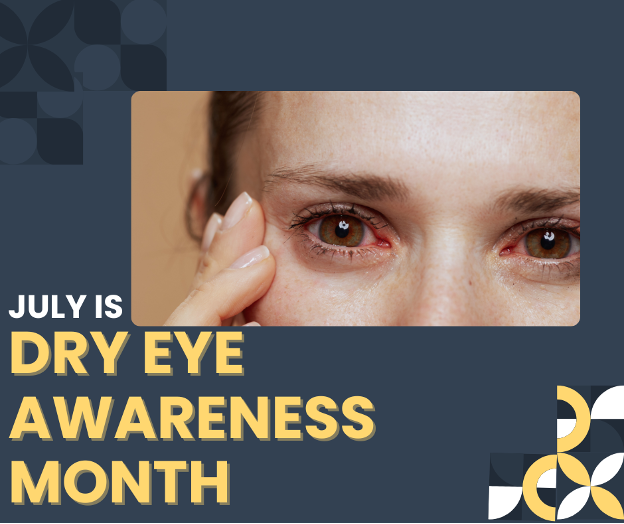Home » Blog » July is Dry Eye Awareness Month
July is Dry Eye Awareness Month
Posted by: Georgia Center for Sight

In 2005, the Sjögren’s Foundation requested that Congress officially declare July “Dry Eye Awareness Month” to increase awareness of dry eye and educate the public about its symptoms and treatment options. The Prevent Blindness organization also designated July as Dry Eye Awareness Month.
Our collaboration with foundations aims to raise awareness about dry eye symptoms and their potential causes. According to the National Eye Institute (NEI), a staggering 16 million Americans suffer from dry eyes, a statistic that underscores the importance of understanding this condition. Dry eye occurs when there is not enough tear film produced, the tear film is not draining properly from the eye, or the tear film is of insufficient quality to maintain the eye’s health.
Risk Factors for Dry Eye
Dry eye is relatively common, and there are many risk factors for dry eye, including:
- Inflammation of the eyelids
- Being 50 years or older
- Medical conditions such as Sjögren’s syndrome, rheumatoid arthritis, and certain other autoimmune diseases
- Women who are pregnant, on certain types of birth control, hormone replacement therapy, or experiencing menopause are likely to have dry eyes.
- Environmental conditions, such as allergies or a dry climate
- Certain medications
What Are Dry Eye Symptoms?
Patients with dry eyes complain of:
- Gritty, sandy feeling
- Itchiness
- Extreme sensitivity, especially to cigarette smoke
- It feels like particles are in the eye
- Redness and inflammation
- Transient blurry vision
- Stringy mucus
- Increased sensitivity to light
If you’re experiencing these symptoms, it’s possible you have dry eye, but other conditions could also be the cause. It’s crucial to remember that a thorough evaluation by your eye doctor is necessary to determine the exact cause of these symptoms. This professional guidance can provide reassurance and ensure the best course of action, giving you the confidence to seek help.
How Can I Prevent Dry Eye?
There are several proactive ways to manage dry eye symptoms, empowering you to take control of your health and well-being.
Stay Hydrated –Hydration is vital! Drinking plenty of water to stay hydrated is excellent for your overall health. It’s also a simple yet effective way to manage your dry eye symptoms, keeping you informed and aware of your condition.
Protect Your Eyes – Protecting your eyes from wind and dust is essential when enjoying activities like biking, hiking, or playing golf outside. Also, don’t forget to BLINK when using a computer or digital device!
Sleep – Get plenty of sleep!
How Is Dry Eye Treated?
There are several options for treating dry eye. The dry eye condition is often misdiagnosed and can cause damage to the front of the eye. If you think you may have dry eyes, call us TODAY to schedule an appointment to determine the best treatment option.

References: American Academy of Ophthalmology, American Optometric Association, Sjögren’s Foundation, National Eye Institute, and Prevent Blindness. This blog provides information and discussion on eye health and related topics. The content provided within this blog and any linked materials are not intended and should not be considered medical advice. If the reader or any person has a medical concern, they should consult with an appropriately licensed physician.
